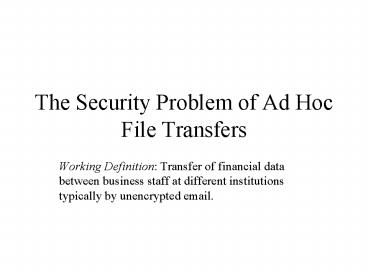The Security Problem of Ad Hoc File Transfers PowerPoint PPT Presentation
1 / 8
Title: The Security Problem of Ad Hoc File Transfers
1
The Security Problem of Ad Hoc File Transfers
- Working Definition Transfer of financial data
between business staff at different institutions
typically by unencrypted email.
2
Problems
- Staff is often unaware of the need for
confidentially. - Staff is not aware that aware that standard email
is not secure. - Lack of accessible tools and training for
encryption.
3
Encryption Tools
- Open PGP (GPG)
- Secret Agent
- Web Mailbox
- PKZIP
- SMIME
4
What is SMIME?
- S/MIME was developed through a consortium of
manufacturers. Only the second version met with
response. - The second version of S/MIME essentially is based
on RFC 2311 (Message Specification) and RFC 2312
(Certificate Handling) as well as RFC 2314
(PKCS10) and RFC 2315 (PKCS7). Those RFCs are
absolutely informative, i.e. IETF did not declare
S/MIME v2 as a standard. - Version 3 was passed from the IETF in July 1999
and essentially is based on RFC 2630
(Cryptographic Message Syntax), RFC 2633 (Message
Specification), RFC 2632 (Certificate Handling)
and RFC 2631 (Diffie-Hellman Key Agreement
Method). Currently most products are based on
version 2, as most manufacturers did not complete
the integration of S/MIME v3 so far. - The concept of S/MIME provides a hierarchic
structure and requires a trustworthy instance
(Certificate Authority) for the trust model.
Compared to PGP there have been many
manufacturers implementing S/MIME from the
outset. That is why there were big problems
regarding the interoperability of several
products. The bigger part of those problems seem
to be solved by now.
5
In Plain English
- SMIME provides public/private key encryption and
signing. - Unlike GPG which use a web of trust, SMIME
utilizes certificates that are signed by a
trusted third party.
6
Why SMIME?
- SMIME is built into most commercial mail agents
i.e. Outlook, Netscape and groupwise. - SMIME is easy to use for those without technical
backgrounds.
7
Obstacles
- Requires the use of a signed X.509 certificates.
- Utilizes special email headers which may cause
problems in certain environments - Encrypted attachments cannot be scanned for
viruses.
8
Getting a Digital ID (Certificate)
- Verisign (15/year)
- Thawte (free)
- Selfsigned certs (OpenSSL)

